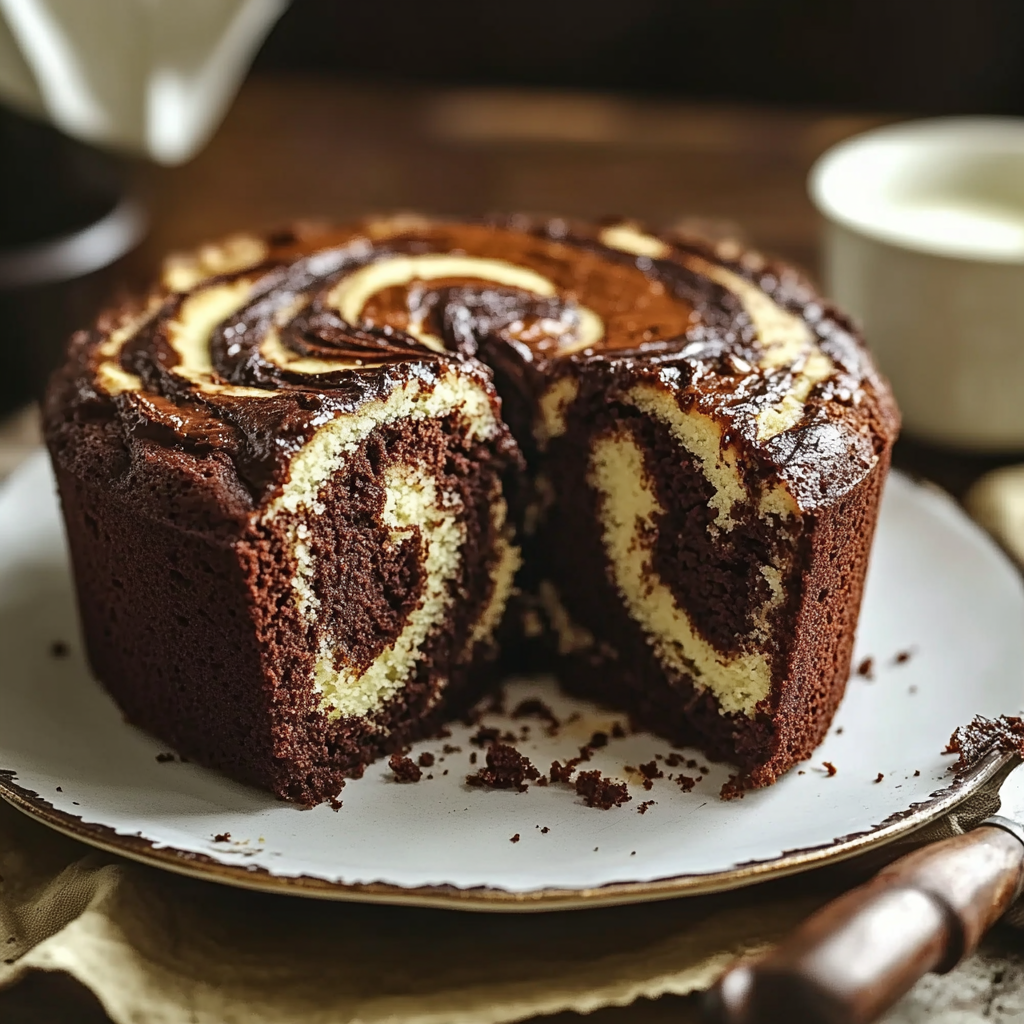The swirl of chocolate and vanilla in this Marble Cake isn’t just visually stunning—it’s a flavor match made in heaven. The buttery richness paired with the softness of sour cream creates a cake that is incredibly moist and tender.
Whether you’re baking for a casual family get-together or simply treating yourself to a cozy afternoon with coffee, this loaf is timeless. With its eye-catching marbled effect and old-fashioned flavor, it’s the kind of dessert that warms hearts and sparks nostalgia. It’s also simple to make, using ingredients you likely already have in your kitchen.
Full Recipe
Ingredients:
-
2 cups all-purpose flour
-
1 ½ teaspoons baking powder
-
½ teaspoon baking soda
-
¼ teaspoon salt
-
1 cup unsalted butter, softened
-
1 cup granulated sugar
-
3 large eggs
-
2 teaspoons vanilla extract
-
1 cup sour cream
-
¼ cup whole milk
-
¼ cup unsweetened cocoa powder
-
2 tablespoons hot water
Directions:
-
Preheat oven to 350°F (175°C). Grease and flour a 9×5-inch loaf pan.
-
In a medium bowl, whisk together the flour, baking powder, baking soda, and salt.
-
In a large mixing bowl, cream the butter and sugar together until light and fluffy.
-
Add eggs one at a time, beating well after each addition. Stir in the vanilla extract.
-
Mix in the sour cream and milk until well combined.
-
Gradually add the dry ingredients to the wet mixture, mixing until just incorporated.
-
Divide the batter in half. In a small bowl, mix cocoa powder with hot water until smooth, then stir into one half of the batter.
-
Alternate spoonfuls of vanilla and chocolate batter into the prepared loaf pan. Use a knife to gently swirl the batters together for a marbled effect.
-
Bake for 50-60 minutes, or until a toothpick inserted into the center comes out clean.
-
Let the cake cool in the pan for 10 minutes, then transfer to a wire rack to cool completely.
Prep Time: 20 minutes | Cooking Time: 55 minutes | Total Time: 1 hour 15 minutes
Kcal: 360 kcal | Servings: 8 slices
A Timeless Classic: The Story Behind Marble Cake
Marble cake is one of those nostalgic bakes that transcends generations. Known for its beautiful swirls of vanilla and chocolate, this cake has graced family tables, afternoon teas, and birthday parties for decades. It’s a classic recipe that combines simplicity with stunning visual appeal, making it as satisfying to look at as it is to eat.
The origins of marble cake can be traced back to 19th-century Germany, where it was first made with molasses and spices. Over time, especially as it made its way into American kitchens, chocolate became the preferred addition. The modern version—alternating batters of vanilla and cocoa, swirled together before baking—became a staple in many households during the mid-20th century. It became especially popular as a loaf cake, easy to slice and serve, and ideal for casual and formal occasions alike.
Why Marble Cake Stands Out Among Other Cakes
What sets marble cake apart isn’t just its aesthetics—though the swirling patterns certainly make it a showstopper. It’s the flavor profile and texture that truly make it memorable. By combining two batters in one bake, it offers a dual-taste experience that keeps each bite interesting. The vanilla brings a light, sweet familiarity, while the chocolate offers richness and depth.
Another notable trait is the texture. When made properly, marble cake is incredibly moist thanks to ingredients like sour cream or yogurt, which keep the crumb tender without making it too dense. It walks the line between light sponge and rich pound cake, appealing to those who enjoy both worlds.
Perfect for All Occasions
One of the greatest advantages of marble cake is its versatility. It’s understated enough to serve as a casual coffee or tea cake yet elegant enough to be part of a formal dessert spread. You can serve it plain, dusted with powdered sugar, or topped with a glaze for an extra touch of sweetness and sophistication.
Whether you’re baking for a Sunday brunch, a birthday celebration, a potluck dinner, or simply to satisfy your own sweet tooth, marble cake fits the bill. It stores well, travels well, and doesn’t require elaborate decorations, making it one of the most convenient cakes to prepare and serve.
Tips for Achieving the Perfect Marble Effect
Swirling the batters may look complex, but it’s quite simple with a little care. The key is not to overmix when swirling—less is more. Use a butter knife or skewer to gently pull through the batter in a figure-eight pattern. This ensures a balanced distribution of chocolate and vanilla without blending them too much.
Another tip is to layer the batters rather than just dolloping them all at once. Add a few spoonfuls of vanilla, then chocolate, and alternate until you’ve used all the batter. This method makes it easier to control the marbling and creates more defined swirls.
Ingredient Quality Matters
Like many simple recipes, marble cake shines when made with quality ingredients. Because there are no frostings or complex fillings to hide behind, the flavor of the butter, vanilla, and cocoa takes center stage. Use real vanilla extract instead of imitation. Choose unsweetened cocoa powder that’s rich and robust. And opt for full-fat dairy ingredients like sour cream or whole milk to enhance the cake’s tenderness.
The butter should be room temperature and unsalted, allowing for better control over the cake’s flavor balance. Fresh eggs contribute to the structure and richness, and good flour (preferably unbleached all-purpose) ensures a stable yet tender crumb.
Modern Twists on the Classic Marble Cake
While the traditional version remains a favorite, bakers often experiment with new twists to keep things exciting. Some modern variations include:
-
Espresso Marble Cake: Add a hint of espresso to the chocolate batter for a mocha vibe.
-
Nutty Marble Cake: Swirl in chopped hazelnuts or pecans for texture and added flavor.
-
Citrus-Infused Vanilla Batter: Add orange or lemon zest to the vanilla batter for a fresh zing.
-
Layered Marble Cake: Bake the batter in layers instead of a loaf, stacking and frosting for a celebration-style cake.
You can also experiment with glazes. A simple chocolate ganache or vanilla glaze can elevate the loaf to a bakery-style presentation. Powdered sugar is a classic topping that adds elegance without overpowering the flavor.
How to Store and Serve Marble Cake
Marble cake is best served at room temperature, where the flavors are at their peak and the texture is soft and tender. If you’ve just baked it, allow it to cool completely before slicing. Cutting while warm can lead to crumbling or gummy texture.
To store, wrap the cooled cake tightly in plastic wrap or place it in an airtight container. It will stay fresh at room temperature for 2-3 days. For longer storage, refrigerate it (well-wrapped) for up to a week. You can also freeze marble cake by slicing it and wrapping each piece individually before placing them in a freezer-safe bag.
To thaw, leave it at room temperature for 1-2 hours or microwave individual slices for 15-20 seconds.
Marble Cake Around the World
Different cultures have adopted and adapted the marble cake into their culinary traditions. In some countries, it’s made with yeast doughs, producing a more bread-like cake. In others, it’s a popular treat during holidays and festivals, often spiced or laced with regional flavors.
In the United States, it’s a favorite in old-fashioned diners and bakeries. In Germany, where it originated, it’s known as “Marmorkuchen” and is often made with a bundt pan for a more decorative shape. In the Middle East and South Asia, versions might include cardamom, rose water, or saffron, blending traditional tastes with the familiar marbled pattern.
Why This Recipe Works So Well
The balance of flavors and textures is what makes this recipe so successful. The batter is moist but not too rich, sweet but not overly sugary, and the marbling offers a visual and sensory contrast in every bite. It also works well for all skill levels—beginners will find it approachable, while experienced bakers can appreciate the subtleties of perfecting the swirl.
Another reason this recipe is a go-to for many is its forgiving nature. You don’t need fancy equipment or rare ingredients. Most kitchens already have the tools and supplies needed. And even when the marbling isn’t perfect, the cake will still taste delicious.
Conclusion
Marble cake is more than just a pretty dessert—it’s a piece of baking history that continues to charm with every swirl. Its simplicity, adaptability, and crowd-pleasing flavor make it an essential recipe in any home baker’s collection. Whether you’re making it for the first time or the hundredth, this cake delivers on taste, texture, and timeless appeal.
From humble beginnings in German kitchens to modern-day global dessert tables, the marble cake has remained a beloved treat. Its charm lies not just in its elegant swirls, but in the way it brings people together, slice by delicious slice.
So the next time you’re looking for a cake that’s easy to make, visually stunning, and unfailingly delicious, remember the marble cake. It’s a recipe that proves classic never goes out of style.








